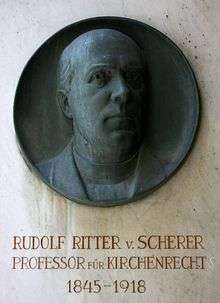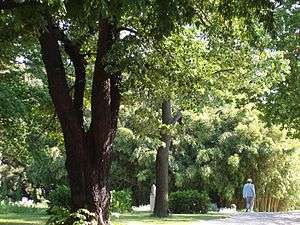University of Vienna
| Universität Wien | |
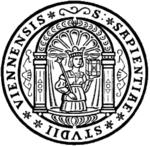 | |
| Latin: Universitas Vindobonensis, also called Alma Mater Rudolphina | |
| Type | Public |
|---|---|
| Established | 1365 |
| Budget | € 544 million[1] |
| President | Heinz Engl |
Academic staff | 6,765 |
Administrative staff | 3,106 |
| Students | 94,000[2] |
| Postgraduates | 16,490 |
| 8,945 | |
| Location |
Vienna, Austria 48°12′47″N 16°21′35″E / 48.21306°N 16.35972°ECoordinates: 48°12′47″N 16°21′35″E / 48.21306°N 16.35972°E |
| Campus | Urban |
| Colors | Blue and White |
| Affiliations | Campus Europae, EUA, UNICA |
| Website |
www |
| Data as of 2016 | |
The University of Vienna (German: Universität Wien) is a public university located in Vienna, Austria. It was founded by Duke Rudolph IV in 1365 and is one of the oldest universities in the German-speaking world. With its long and rich history, the University of Vienna has developed into one of the biggest universities in Europe, and also one of the most renowned, especially in the Humanities. It is associated with 15 Nobel prize winners and has been the academic home of a large number of figures both of historical and academic importance.
History
From the Medieval Age to the Enlightenment

The University was founded on 12 March 1365 by Rudolf IV, Duke of Austria, and his two brothers, Dukes Albert III and Leopold III, hence the additional name "Alma Mater Rudolphina". After the Charles University in Prague and Jagiellonian University in Kraków, the University of Vienna is the third oldest university in Central Europe and the oldest university in the contemporary German-speaking world; it remains a question of definition as the Charles University in Prague was German-speaking when founded, too.
The University of Vienna was modelled after the University of Paris. However, Pope Urban V did not ratify the deed of foundation that had been sanctioned by Rudolf IV, specifically in relation to the department of theology. This was presumably due to pressure exerted by Charles IV, Holy Roman Emperor, who wished to avoid competition for the Charles University in Prague. Approval was finally received from the Pope in 1384 and the University of Vienna was granted the status of a full university, including the Faculty of Catholic Theology. The first university building opened in 1385. It grew into the biggest university of the Holy Roman Empire, and during the advent of Humanism in the mid-15th century was home to more than 6,000 students.
In its early years, the university had a partly hierarchical, partly cooperative structure, in which the Rector was at the top, while the students had little say and were settled at the bottom. The Magister and Doctors constituted the four faculties and elected the academic officials from amidst their ranks. The students, but also all other Supposita (university members), were divided into four Academic Nations. Their elected board members, mostly graduates themselves, had the right to elect the Rector. He presided over the Consistory which included procurators of each of the nations and the faculty deans, as well as over the University Assembly, in which all university teachers participated. Complaints or appeals against decisions of faculty by the students had to be brought forward by a Magister or Doctor.
Being considered a Papal Institution, the university suffered quite a setback during the Reformation. In addition, the first Siege of Vienna by Ottoman forces had devastating effects on the city, leading to a sharp decline, with only 30 students enrolled at the lowest point. For King Ferdinand I, this meant that the university should be tied to the church to an even stronger degree, and in 1551 he installed the Jesuit Order there. With the enacting of the Sanctio Pragmatica edict by emperor Ferdinand II in 1623, the Jesuits took over teaching at the theological and philosophical faculty, and thus the university became as stronghold of Catholicism for over 150 years. It was only in the Mid-18th century that Empress Maria Theresa forced the university back under control of the monarchy. Her successor Joseph II helped in the further reform of the university, allowing both Protestants and Jews to enroll as well as introducing German as the compulsory language of instruction.
From the 19th century onwards

Big changes were instituted in the wake of the Revolution in 1848, with the Philosophical Faculty being upgraded into equal status as Theology, Law and Medicine. Led by the reforms of Leopold, Count von Thun und Hohenstein, the university was able to achieve a larger degree of academic freedom. The current main building on the Ringstraße was built between 1877 and 1884 by Heinrich von Ferstel. The previous main building was located close to the Stuben Gate (Stubentor) on Iganz Seipel Square, current home of the old University Church (Universitätskirche) and the Austrian Academy of Sciences (Österreichische Akademie der Wissenschaften). Women were admitted as full students from 1897, although their studies were limited to Philosophy. The remaining departments gradually followed suit, although with considerable delay: Medicine in 1900, Law in 1919, Protestant Theology in 1923 and finally Roman Catholic Theology in 1946. Ten years after the admission of the first female students, Elise Richter became the first woman to receive habilitation, becoming professor of Romance Languages in 1907; she was also the first female distinguished professor.
In the late 1920s, the university was in steady turmoil because of anti-democratic and anti-semite activity by parts of the student body. Professor Moritz Schlick was killed by a former student while ascending the steps of the University for a class. His murderer was later released by the Nazi Regime. Following the Anschluss, the annexation of Austria into Greater Germany by the Nazi regime, in 1938 the University of Vienna was reformed under political aspects and a huge number of teachers and students were dismissed for political and "racial" reasons.[3] In April 1945, the then 22-year-old Kurt Schubert, later acknowledged doyen of Judaic Studies at the University of Vienna, was permitted by the Soviet occupation forces to open the university again for teaching, which is why he is regarded as the unofficial first rector in the post-war period. On 25 April 1945, however, the constitutional lawyer Ludwig Adamovich senior was elected as official rector of the University of Vienna. A large degree of participation by students and university staff was realized in 1975, however the University Reforms of 1993 and 2002 largely re-established the professors as the main decision makers. However, also as part of the last reform, the university after more than 250 years being largely under governmental control, finally regained its full legal capacity back. The number of faculties and centers was increased to 18, and the whole of the medical faculty separated into the new Medical University of Vienna.
Location

The University of Vienna does not have one single campus. The academic facilities occupy more than sixty locations throughout the city of Vienna. The historical main building on the Ringstraße constitutes the university's centre and is commonly referred to as "die Uni". Most other larger university facilities and lecture halls are located nearby in the area of Vienna's First and Ninth District: the so-called new Lecture Hall Complex (Neues Institutgebäude, NIG), the lecture hall complex Althanstraße (UZA), the campus on the premises of the Historical General Hospital of Vienna, the Faculty of Law (Juridicum) and others. The Botanical Garden of the University of Vienna is housed in the Third District, as are the Department of Biochemistry and related research centres.
Also worth mentioning is the Vienna Observatory, which belongs to the university, and the Institute for University Sports (USI), which offers training and recreational possibilities to all students of the university.
In addition, the University of Vienna maintains facilities outside of Vienna in the Austrian provinces of Lower Austria, Upper Austria and Salzburg. These are mainly research and experimental departments for Biology, Astrophysics and Sports.
Organization
The University of Vienna, like all universities and academies in Austria, once featured a system of democratic representation. Power in the university was divided equally among three groups: students (the largest group), junior faculty and full professors. All groups had the right to send representatives to boards, who then voted on almost every issue. From 2002 on, the government of Austria, headed by chancellor Wolfgang Schüssel, reformed the university system, transforming the institutions into legal entities, but also concentrating power in the hands of the full professors.[4] The reform also introduced a board of governors and tuition fees. In 2013 those amounted to about €381 per semester for students from Austria, the European Union as well as some non-EU countries, while students from developed non-EU countries usually pay double that amount. The reforms also separated the medical departments into separate medical schools, such as the Medical University of Vienna.
Programmes
Students at the university can select from 181 degree programmes: 55 bachelor programmes, 110 master programmes, 3 diploma programs and 13 doctoral programmes. In the academic year 2013/14, the university awarded 7,745 first degrees (Bachelors and Diplomas), 1,424 Master's degrees and 568 Doctoral degrees. The university offers a number of Masters programs in English, namely:
- Quantitative Economics, Management and Finance
- Science-Technology-Society
- Environmental Sciences
- Middle European interdisciplinary Master Programme in Cognitive Science
- European Master in Health and Physical Activity
- English Language and Linguistics
- Anglophone Literatures and Cultures
- East Asian Economy and Society
- Economics
- Botany
- Ecology and Ecosystems
- Molecular Microbiology, Microbial Ecology and Immunobiology
- European Master in Urban Studies
- Masters in European and International Business Law
Some 6,900 scholars undertake the research and teaching activity of the university. Of these, approximately 1,000 engage actively in projects financed by third parties. The main fields of research at the university cover a wide spectrum of subjects: Catholic and Protestant Theology, Law, Economic Sciences and Computer Science, Philological-Cultural Studies and Historical-Cultural Studies, Social Sciences and Psychology, Life Sciences and Natural Sciences, Mathematics, Sports Sciences and Teacher Education.
Faculties and Centres
The University of Vienna consists of 15 faculties and four centres:
- Faculty of Catholic Theology
- Faculty of Protestant Theology
- Faculty of Law
- Faculty of Business, Economics and Statistics (not to be confused with the Vienna University of Economics and Business)
- Faculty of Computer science
- Faculty of Historical and Cultural Studies
- Faculty of Philological and Cultural Studies
- Faculty of Philosophy and Education
- Faculty of Psychology
- Faculty of Social sciences
- Faculty of Mathematics
- Faculty of Physics
- Faculty of Chemistry
- Faculty of Earth Sciences, Geography and Astronomy
- Faculty of Life sciences
- Centre for Translation studies
- Centre for Sport science and University Sports
- Centre for Molecular biology
- Centre for Teacher Education
Famous members
Faculty and scholars
Nobel Prize Laureates who taught at the University of Vienna include Robert Bárány, Julius Wagner-Jauregg, Hans Fischer, Karl Landsteiner, Erwin Schrödinger, Victor Franz Hess, Otto Loewi, Konrad Lorenz and Friedrich Hayek.
The University of Vienna was the cradle of the Austrian School of economics. The founders of this school who studied and later instructed at the University of Vienna included Carl Menger, Eugen von Böhm-Bawerk, Friedrich von Wieser, Joseph Schumpeter, Ludwig von Mises and Friedrich Hayek.
Other famous scholars who have taught at the University of Vienna are: Theodor W. Adorno, Alexander Van der Bellen, Manfred Bietak, Theodor Billroth, Ludwig Boltzmann, Franz Brentano, Anton Bruckner, Rudolf Carnap, Conrad Celtes, Viktor Frankl, Sigmund Freud, Eduard Hanslick, Edmund Hauler, Leon Kellner, Hans Kelsen, Adam František Kollár, Johann Josef Loschmidt, Fran Miklošič, Oskar Morgenstern, Otto Neurath, Johann Palisa, Pope Pius II, Elise Richter, Baron Carl von Rokitansky, Rudolf von Scherer, August Schleicher, Moritz Schlick, Ludwig Karl Schmarda, Joseph von Sonnenfels, Josef Stefan, Olga Taussky-Todd, Leopold Vietoris, Jalile Jalil, Carl Auer von Welsbach, and Wilhelm Winkler.
Alumni
Some of the University's better-known students include: Kurt Adler, Franz Alt, Wilhelm Altar, Maria Anwander, Bruno Bettelheim, Rudolf Bing, Lucian Blaga, Hedda Bolgar, Josef Breuer, F. F. Bruce, Elias Canetti, Ivan Cankar, Otto Maria Carpeaux, Christian Doppler, Felix Ehrenhaft, Mihai Eminescu, Paul Feyerabend, Heinz Fischer, O. W. Fischer, Ivan Franko, Sigmund Freud, Alcide De Gasperi, Kurt Gödel, Ernst Gombrich, Erich Göstl, Franz Grillparzer, Jörg Haider, Theodor Herzl, Hugo von Hofmannsthal, Edmund Husserl, Marie Jahoda, Elfriede Jelinek, Percy Lavon Julian, Karl Kautsky, Elisabeth Kehrer, Leon Kellner, Hans Kelsen, Rudolf Kirchschläger, Arthur Koestler, Jernej Kopitar, Karl Kordesch, Arnold Krammer, Karl Kraus, Bruno Kreisky, Richard Kuhn, Paul Lazarsfeld, Ignacy Łukasiewicz, Gustav Mahler, Tomáš Garrigue Masaryk, Lise Meitner, Gregor Mendel, Karl Menger, Franz Mesmer, Franc Miklošič, Alois Mock, Matija Murko, Joachim Oppenheim, Eduard Pernkopf, Anton Piëch, Pope Pius III, Maxim Podoprigora, Hans Popper, Karl Popper, Otto Preminger, Wilhelm Reich, Peter Safar, Mordkhe Schaechter, Karl Schenkl, Arthur Schnitzler, Albin Schram, Joseph Schumpeter, Wolfgang Schüssel, John J. Shea, Jr., Adalbert Stifter, Countess Stoeffel, Yemima Tchernovitz-Avidar, Eric Voegelin, Kurt Waldheim, Otto Weininger, Slavko Wolf, Eduard Zirm,Mordecai Sandberg,Stefan Zweig, and Huldrych Zwingli.
Prominent African-American alumni include chemist and inventor Percy Julian, dermatologist and philanthropist Theodore K. Lawless, and concert organist, music theorist and music educator Calvin Edouard Ward, also the recipient of three Fulbright awards.
Nobel Prize Laureates
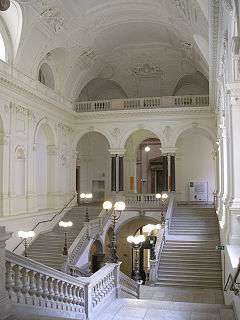
There are total 15 Nobel Prize Laureates affiliated to the University as follows:
| Name | Field In | Year |
|---|---|---|
| Robert Bárány | Physiology or Medicine | 1914 |
| Richard Adolf Zsigmondy | Chemistry | 1925 |
| Julius Wagner-Jauregg | Physiology or Medicine | 1927 |
| Hans Fischer | Chemistry | 1930 |
| Karl Landsteiner | Physiology or Medicine | 1930 |
| Erwin Schrödinger | Physics | 1933 |
| Otto Loewi | Physiology or Medicine | 1936 |
| Victor Francis Hess | Physics | 1936 |
| Richard Kuhn | Chemistry | 1938 |
| Max Perutz | Chemistry | 1962 |
| Karl von Frisch | Physiology or Medicine | 1973 |
| Konrad Lorenz | Physiology or Medicine | 1973 |
| Friedrich Hayek | Economics | 1974 |
| Elias Canetti | Literature | 1981 |
| Elfriede Jelinek | Literature | 2004 |
The University Library
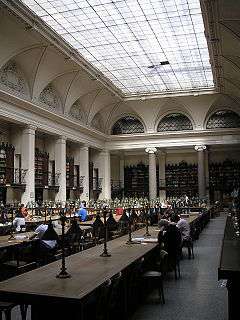
The University Library of the University of Vienna comprises the Main Library and the 50 departmental libraries at the various university locations throughout Vienna. The library's primary responsibility is to the members of the university; however, the library's 350 staff members also provide access to the public. Use of the books in the reading halls is open to all persons without the need for identification, which is only required for checking out books. The library's website provides direct access to information such as electronic journals, online indices and databases.
Library history
Rudolf IV had already provided for a publica libraria in the Foundation Deed of 12 March 1365, where the valuable books bequeathed by deceased members of the University should be collected. Through many legacies, this collection was subsequently greatly increased and became the basis of the old Libreye that was accommodated in the same building as the student infirmary. In addition, there were libraries in the separate Faculties and in the Duke's College.
From the 17th Century onwards, interest in the old library, with its manuscripts and incunabulae, went into decline and the modern library in the Jesuit College came to the fore. In 1756, the oldest university library was finally closed down and its books, 2,787 volumes, were incorporated into the Court Library, of which Gerard van Swieten was then director. After the dissolution of the Jesuit order (1773), the new "Academic Library" was created out of the book collections of the five Lower Austrian Colleges and a large number of duplicates from the Court Library. This was opened on 13 May 1777, the birthday of Maria Theresa of Austria, in the building of the Academic College. Initially, the stock consisted of some 45,000 books and during Emperor Joseph II's dissolution of the monasteries, this was soon considerably extended. In contrast to its antecedents, the new library was open to the general public. Between 1827 and 1829, it acquired the classicist extension (Postgasse 9) to the Academic College, in which it was to be accommodated until 1884. In this year, the main library, with some 300,000 books, moved to Heinrich von Ferstel's new Main Building on the Ring, where stacks for some 500,000 volumes had already been prepared. With an annual growth of up to 30,000 volumes, the surplus space was soon filled. Book storage space had to be extended continuously. One hundred years later, the complete library, including departmental and subject libraries, comprised more than 4.3 million volumes. Today, Vienna's University Library is the largest collection of books in Austria, still facing problems of space. In addition to the Main Library, which alone has to cope with an annual growth of 40,000 volumes, it includes three Faculty Libraries, 32 Subject Libraries and 26 Departmental Libraries.[5]
Library statistics
- Book inventory: 7,161,562 (of which 2,722,356 belong to the Main Library)
- Journals: 10,100 in print, 48,000 E-Journals
- Active borrowers: 68,358
- Search queries in the online catalogue: 6,763,621
- Borrowings and renewals of books: 6,084,438
- Oldest book: Pliny the Elder (1469). Historia naturalis.
Data as of 2014
International acclaim
| University rankings | |
|---|---|
| Global | |
| ARWU[6] | 151-200 |
| Times[7] | 161 |
| QS[8] | 154 |
| Europe | |
| ARWU[9] | 54-80 |
| Times[10] | 74 |
| QS[11] | 63 |
The University of Vienna has the highest ranking in Arts and Humanities, where it is placed 35 and 54th in the world according to the THE and QS ranking respectively. Outstanding subjects include Geography (ranked 28th globally in 2013), Linguistics and Philosophy (both 46th globally). It is rated high in academic reputation and number of international students, but low in terms of faculty to student ratio and citations per faculty.[12][13][14]
|
An overview of the QS World University Rankings by subjects:[15]
The Times Higher Education World University Rankings by subjects:[16]
Gallery
See also
Notes and references
External links
| |||||||||||||||||||||||||||||||||||||||||||||||||||||||


